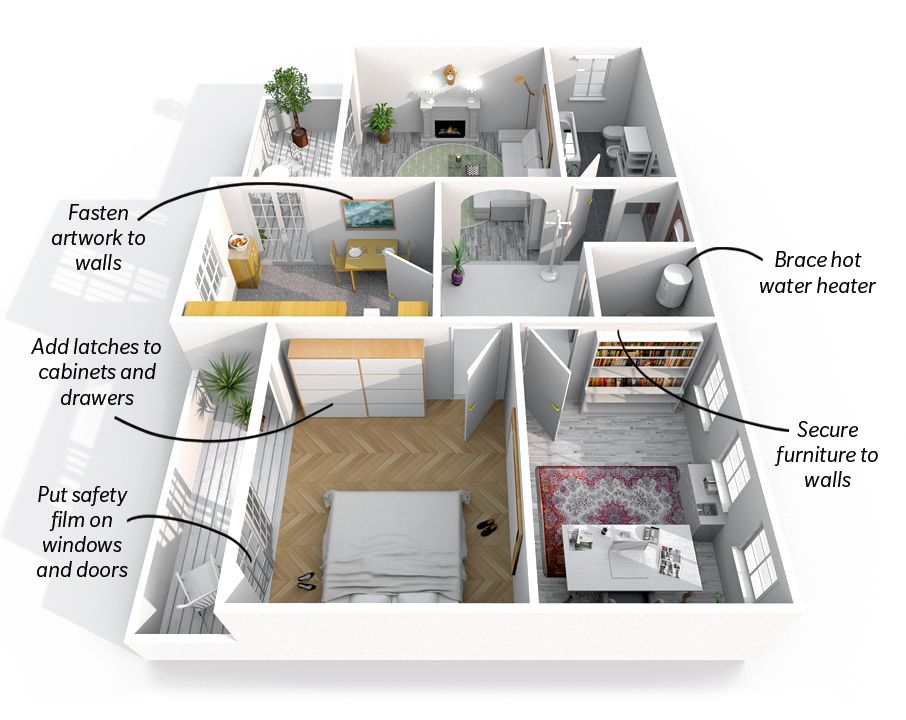Although he studies earthquakes for a living, Keith Knudsen never gets used to them. "It's like a truck slamming into your house that sets off a chain reaction. The earth beneath you moves, then the house, and then everything inside it." Knudsen, deputy director of earthquake science at the U.S. Geological Survey, has lived along the Hayward Fault near Berkley, California, for the past 25 years. "I really shouldn't be surprised. But it happens every year or two, and somehow it's always surprising.
What does the earthquake scientist tell his own family to consider doing when they feel a rumble? "Without a doubt: drop to the floor, cover your head and hold on," Knudsen says. "Hold on to something sturdy like the leg of desk or table, and get under it if you can. Don't run outside, stand in a doorway or do a million other things you might have heard. Just remember: drop, cover, hold on.
Just as important, he says, is having an earthquake preparedness strategy that goes beyond knowing what to do during an earthquake. It's what you do to your home ahead of time, he says, that can help save lives and reduce property damage.
Seismic Improvements You Can Do Yourself
As soon as he moved his family into their 1930s wood-frame house, Knudsen reinforced the walls of the crawlspace and added bolts securing the house to the foundation. The home's hot water heater is now strapped to studs, all large pieces of furniture are anchored to walls, and the refrigerator sits in a cubby so it can't tip over, he says.
"There's a lot you can do to make your home safer," says Tim Reinhold, senior vice president of research and chief engineer for the Insurance Institute for Business and Home Safety (IBHS). "The biggest mistake homeowners make is not doing anything."
Reinhold advises homeowners to consider focusing on the following five areas where a little time and money can help the outcome of an earthquake's impact on your home.
1. Anchor large furnishings to walls.
Think: bookcases, cabinets, large artwork, grandfather clocks and other heavy household furniture that can tip, fall or shatter. DIY anchoring kits are widely available at home improvement stores and typically designed with clear instructions a novice can follow. These kits usually consist of metal fasteners and screws that allow you to attach furniture directly to studs in the wall. For furniture you may need to move away from a wall to clean behind, select kits can include detachable cables that allow you to pull pieces away from the wall.
Expert tip: Don't DIY everything. "Do not attempt to reinforce ceiling fixtures yourself," says Reinhold. "Overhead lights and ceiling fans are attached to an electrical box in the ceiling, so stability in an earthquake boils down to how well that box was installed. Any work to brace or support the box needs to be done by a qualified electrician."
DIY time: 15 minutes/piece of furniture
Cost: $10 per piece
Skill level: Beginner
2. Install safety latches on cabinet doors.
Reinhold recommends "push open" or "touch" latches that require pressure from the outside to open. Unlike DIY child safety latches, push latches are installed inside the cabinet, which means you can't see them and you won't have to fumble with a latch every time you need to grab a glass. Like wall anchors, push latches are typically sold in kits with the required screws and simple installation instructions. The hardest part may be retraining yourself to open cabinets with a gentle tap.
Expert tip: Reinhold recommends leaving a few inches of open space between the contents of the cabinet and the door. "This allows items inside the cabinet to move around without putting pressure on the door."
DIY time: 15 minutes/door
Cost: two to three dollars/door or drawer
Skill level: Beginner

The latest
earthquake?
Check the U S G S
Earthquake Tracker's
interactive map
showing the most
recent magnitude
2.5+ tremors
around the globe.
3. Strap down the water heater.
These appliances are tall, slender and, as Reinhold puts it, "have mass at a high level." This combination makes them inherently unstable when the earth starts moving. If your water heater goes down, you're faced with uncontrolled water release in the house and the risk of an explosion if the unit runs on gas.
Most residential water heaters can be safely secured with metal straps attached to the wall. While this isn't a simple job, all the materials you need are sold in kits with step-by-step guides. Visit Guidelines for Earthquake Bracing of Residential Water Heaters for a diagram and required materials for bracing a hot water heater.
Expert tip: "Flexible connections to water and gas lines are far less likely to break if your water heater moves around," says Reinhold. "If your unit has the old-style rigid connectors, it's best to have them replaced by a professional plumber, which will cost about $150."
DIY time: 40 minutes
Cost: $20+
Skill level: Intermediate
4. Apply safety film to windows.
Flying glass is a major cause of injuries in earthquakes. Safety film is designed to hold a pane of glass together so that even if the window shatters or falls out of the pane, the film keeps the glass from scattering.
Safety film is sold in rolls or pre-cut sections and may be self-adhering or require water to activate an adhesive backing. All require squeegee skills and a bit of technique. The film should be virtually invisible, without any bubbles or creases.
Expert tip: "Some films are marketed as clear, but may actually darken or otherwise change the appearance of the glass when installed," says Reinhold. "Visit a store or showroom that has windows with the film applied on display before you buy."
DIY time: 15 minutes/window
Cost: $35/window
Skill level: Advanced
5. Reinforce cripple walls.
If your home has a crawlspace beneath it, you may need this structural retrofit. Modern residential buildings are typically built on concrete slab-on-grade foundations, but homes built before 1960 were more commonly built on raised foundations or cripple walls. Cripple walls are the side walls of crawlspaces that connect a home to its foundation. They're usually constructed of short wood studs and siding — not the best stuff for supporting a house. The swaying motion caused by an earthquake can cause unbraced cripple walls to collapse, moving the structure off its foundation.
Cripple walls are usually the weakest part of older homes, something that Knudsen addressed right away in his 1930s California home. This retrofit generally involves installing plywood reinforcements to the frame of the walls and bolting them securely to the foundation. The process is commonly known as "brace and bolt."
"This is one of the few structural improvements that can be considered a DIY project, but only in the right hands," notes Reinhold. "You have to really know what you're doing." When it doubt, it is wise to seek the advice or help of a qualified professional.
Expert tip: "Construction plans and drawings for cripple wall retrofits are available free of charge from F E M A and local building authorities, particularly in California," says Reinhold.
DIY time: 1 or more days
Cost: $1,000 for materials
Skill level: DIY Warrior

Oklahoma experienced 888 magnitude 3+ earthquakes in 2015, compared to 130 in California for the same year. - USGS.gov
Written by
The information contained in this page is provided for general informational purposes only. The information is provided by Farmers® and while we endeavor to keep the information up to date and correct, we make no representations or warranties of any kind, express or implied, about the completeness, accuracy, reliability, suitability or availability with respect to this article or the information, products, services or related graphics, if any, contained in this article for any purpose. The information is not meant as professional or expert advice, and any reliance you place on such information is therefore strictly at your own risk.
Related articles



